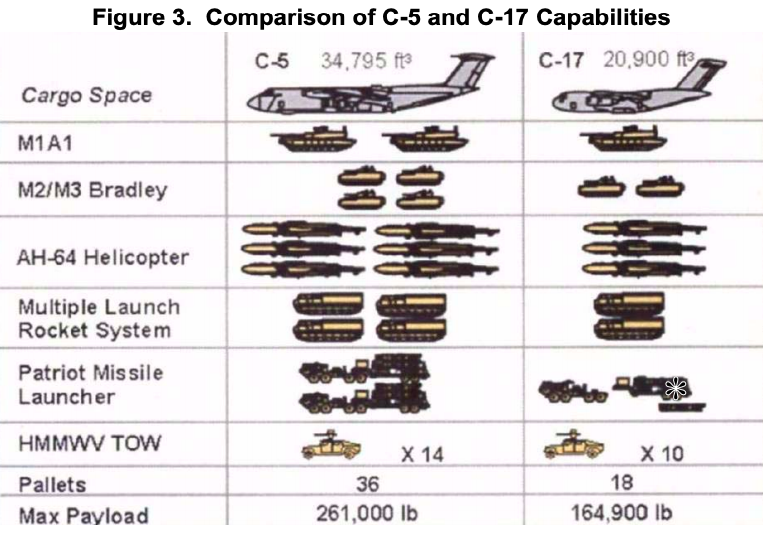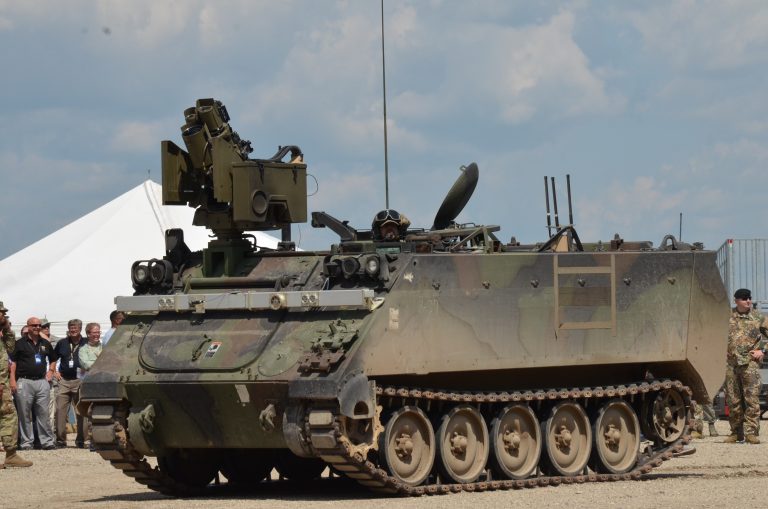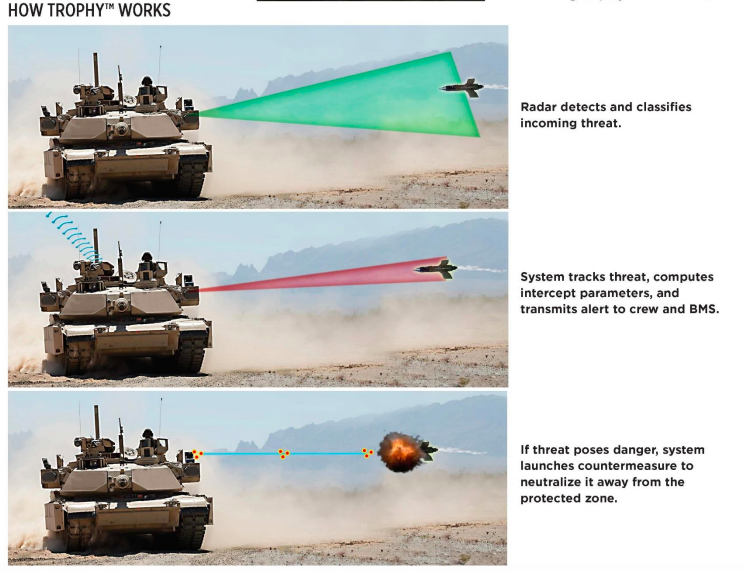NGCV: Hard Choices In Bradley Replacement, RFP Out Friday
The Army will sacrifice some protection to fit two NGCVs on one Air Force C-17.
By SYDNEY J. FREEDBERG JR.
on March 27, 2019
HUNTSVILLE: The Army’s willing to make some tough tradeoffs to move fast and replace its 1980s-vintage M2 Bradley troop carrier. The service will issue a formal Request For Proposals Friday for a new Optionally Manned Fighting Vehicle (OMFV).
After industry warned the service that its original vision was too ambitious to build, Brig. Gen. Ross Coffman said here this morning, the Army made a difficult compromise: reduce the required protection to keep the vehicles small and light enough to fit two on the Air Force’s workhorse C-17 jet transport.
Contractors must submit prototype vehicles (blandly called “bid samples”) to be tested this fall.
The OMFV will have an add-on armor “b-kit” that can be shipped separately and installed by troops in the war zone, if commanders think the threat is great enough, Coffman told reporters at the Association of the US Army’s annual conference here. But the baseline OMFV will weigh roughly as much as the Bradley, about 33 tons in the latest version, which also fits two per C-17. That’s a weight target all three publicly proclaimed contenders — the BAE CV90, General Dynamics Griffin, and Rheinmetall-Raytheon Lynx — should all be able to meet.
By contrast, two cancelled prior programs either went too high or too low. The Ground Combat Vehicle would have weighed as much as an M1 Abrams, which fits one per C-17. The infamous Future Combat Systems tried to cram all its capabilities into a turboprop C-130, which can take off — barely — with 20 tons aboard.
“We went to school on our past failures as a service,” said Coffman, who heads the Army’s Cross Functional Team for Next Generation Combat Vehicles (NGCV), the service’s No. 2 modernization priority after long-range artillery. “You can write a requirement that is unattainable, and that’s why at least one major, major, major program for the United States army failed previously.”
 A single C-17 (right column) can carry 1 M1 Abrams main battle tank, two M2 Bradley infantry fighting vehicles, or three partially disassembled AH-64 Apache helicopters. SOURCE: Lockheed Martin
No Blood For Unobtainium
A single C-17 (right column) can carry 1 M1 Abrams main battle tank, two M2 Bradley infantry fighting vehicles, or three partially disassembled AH-64 Apache helicopters. SOURCE: Lockheed Martin
No Blood For Unobtainium
Many in the defense industry were clearly anxious this latest attempt to replace the Bradley might go the way of its two predecessors and be canceled. A complaint that the OMFV requirements were unachievable was the first thing I heard on arrival in Huntsville for the conference — before I even left the airport — and the concern came up as a question for the first Army speaker, Futures Command chief Gen. John “Mike” Murray, who deferred to Coffman. Coffman and his team are confident they’ve solved that problem.
The plan was always to start with a highly ambitious draft requirement, then get industry feedback and dial back where necessary, Coffman said. If you start out too modest, he said, you don’t push industry to its utmost, so you might never find out they could have given you something better if only you’d asked. The whole point of writing a draft is to revise it, after all, and the whole point of releasing a draft for comment is to pay attention to the comments you get instead of ignoring them.
The problem was two-fold, Coffman said. One issue was sheer weight. The draft requirement called for so much protection on the baseline vehicle (as opposed to the bolt-on b-kit) that the OMFV came in too heavy for the C-17. The other issue was height, since ground clearance — the distance between the ground and the bottom of the hull — is the first line of defense against roadside bombs and land mines: The OMFV would’ve been too tall.
“There’s the triad, right: lethality survivability and mobility,” Coffman said. “We want two OMFVs per C-17. If you push the survivability standard so high, then you need incredible armor protection, you need incredible height of the vehicle, based on blast.”
 Experimental robotic M113 armored vehicle (with human monitor aboard for safety) at Camp Grayling in 2017
More Compromises: From Guns To Robotics
Experimental robotic M113 armored vehicle (with human monitor aboard for safety) at Camp Grayling in 2017
More Compromises: From Guns To Robotics
The Army’s making other compromises to get the Bradley replacement faster and on budget. As previously announced, the service won’t require the vehicle to transport a full nine-soldier infantry squad, something the Bradley can’t do either but was a major driver of the cancelled Ground Combat Vehicle’s tremendous size.
Offensively, the service wants the OMFV to carry a 50mm cannon — the “objective requirement” — but it will accept 30 mm — the “threshold requirement.” (The current Bradley’s gun is 25 mm). That said, Coffman added, if a company comes in with a 30mm weapon, “they have to show us a path to 50.”
The Army will also accept a second-generation FLIR (Forward Looking Infra-Red) sight — found on many vehicles today — rather than waiting for third-gen FLIR, but again it wants to be able to upgrade later.
Defensively, the vehicle will also have the Army’s new Modular Active Protection System (MAPS), meant to disable incoming anti-tank missiles and rockets before they ever hit the armor. While the Army’s urgently adding off-the-shelf active protection like Rafael’s Trophy and IMI’s Iron Fist to its existing vehicles, it doesn’t want to be tied to any one contractor in the future. So MAPS is meant to be a plug-and-play open architecture that can easily be upgraded with new sensors, jammers, and “hard kill” mini-missiles, mixing and matching the best technologies available from any vendor.
The potential for future upgrades is especially critical because present-day active protection systems can’t stop everything a Russian or Chinese tank can shoot at you.
Today’s APS does pretty well against the most powerful weapons most guerrillas can muster: unguided rockets (RPGs) and anti-tank guided missiles (ATGMs), which both rely on high explosive warheads to breach the target’s armor. But modern APS can’t stop high-velocity solid shot, the so-called “long-rod penetrators” — essentially, giant steel darts with needle-like tips — that penetrate armor by applying tremendous kinetic energy to a single point.
 How the Trophy Active Protection System works (Rafael graphic)
How the Trophy Active Protection System works (Rafael graphic)
“You have RPGs, you’ve got missiles, and then you have long-rod penetrators,” Coffman said. “Our APS are going to have to defeat all of those three in the future, the third being the hardest.”
Overall, one thing the Army will not compromise on its upgradeability: The initial OMFV must have plenty of room for growth. “We’re not willing to take risk in our ability to have multiple increments of this vehicle,” Coffman said.
The other thing the Army won’t compromise, despite the tradeoffs to fit into the C-17? Protection for the soldiers aboard the vehicle.
“Survivability of our soldiers is paramount,” Coffman said. “It’s No. 1.”
While Coffman didn’t say this explicitly, survivability of the soldiers is distinct from the survivability of the vehicle itself. If the OMFV is totaled but everyone walks out of the wreckage alive, that’s a win.
In this wider understanding of survivability, the best way to protect the troops is to take them out of the vehicle altogether. That’s a big part of why the Bradley replacement will be the Optionally Manned Fighting Vehicle. Coffman’s NGCV team is also working on completely unmanned Robotic Combat Vehicles, with the first platoon-sized experiment — four robots and two manned command vehicles — scheduled for next year.
These aren’t sci-fi killer robots, however. At least initially, “unmanned” will mean “remotely controlled,” with two human operators — a driver and a gunner/sensor operator — teleoperating each unmanned machine. Over time, however, the Army expects to upgrade as technology improves, first getting down to one human remote-controlling one unmanned vehicle, then having one human supervise multiple robots. But the Army never wants to take the human out of the loop, so keeping communications open between man and machine is critical.
Current encrypted radio technology can communicate over about 20 kilometers (12.5 miles), Coffman said. It doesn’t yet have the massive bandwidth required to relay video of an unmanned vehicle’s surroundings, but he’s confident he and Army Futures Command‘s other Cross Functional Teams — the network, long-range firepower, et al. — can overcome that limitation.
“While it’s going to require a bigger pipe, I think technology’s going to get us to about 18 kilometers [11 miles],” Coffman said. That stand-off distance, he said, “when you combine it with all the CFT efforts, is about what we need to continue to fight the way we want to fight and to protect our soldiers.”
https://breakingdefense.com/2019/03/ngc ... ut-friday/




